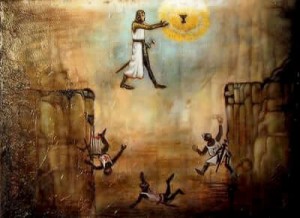Speak about the “Holy Grail” is to speak on one side of medieval legends and stories fictionalized under the chivalrous ideal of XII c. and on the other side is speak of a real relic, that after a long historical journey of many centuries, came and is still in the Cathedral of Valencia.
The Grail legend, with all its symbolic, magical and religious connotations, owes its birth to one of the stories that over nearly a millennium has given rise to legends, fables and all imaginable novelistic plots that today it is still able to move the people’s interest by its “hidden” connotations. The “grail” word itself comes from the Latin word “gradulus” = dish (bowl to carry food at different times or “gradus” a feast), Which in ancient Occitan Language derive in “gradalis” or “gradale” and in vernacular language was called “grail.” Also in some medieval texts appeared transcribed as “San Greal” (Francophone word derived of a supposed form of “royal blood”) leading to esoteric interpretations of descendants of Jesus Christ.
The first literary mention of the Grail corresponds to a French cleric called Chretien of Troyes, which between 1160 and 1190 he wrote “The Tale of the Grail” (or “Percival”) in which appeared an object of Christian symbolism, but Chrétien he can´t explained what it was the grail, the writing work stopped abruptly. If the work of Chretien de Troyes marked the beginning of the legend, it was little later Robert de Boron and Wolfram von Eschenbach who would develop the legend knew in the Medieval Europe. Robert de Boron in his work “Joseph d’Arimathie and Saint Grail Stories”, was responsible for transforming the “grail” of Chrétien in “The Holy Grail”, spiritualized and become the cup of the Last Supper in which Joseph of Arimathea collected the blood from the wounds of Christ during the crucifixion. Boron also claimed that Joseph and his family took the Grail to Britain, so linking the biblical story with the Arthurian legend. The German writer Wolfram von Eschenbach wrote later “Parsifal” (which inspired Richard Wagner’s opera); in, parallel with the French novel of Boron. He developed specific elements such as the identification of the Grail with a gemstone (known as “Lapis Exillis” of Apocalypse) which provided food, youthood, prevented aging, curing diseases, and was guarded by a Brotherhood of Warrior Monks. The newness that brought Eschenbach was the harmonization of two facets difficult to combine: The Chivalrous Service and the Christian Service. A third Cycle of most extensive novels, composed in prose, were the “Arthurian Vulgate “; these novels were written anonymously during the XIII c., with the theme of the Grail and directly related to the Arthurian Legend, which consecrate definitively the Christianization of the Myth. The cycle is a set of three books (Lanzarote, The Grail Quest and the Death of King Arthur) in these three books, collected everything previously written about the topic plot, from the origin of the Grail to the disappearance of the Arthurian World under the prism of religious Quest for the Holy Grail. The literary theme of the Holy Grail remained latent from the XIV c. almost until the XIX c. taking root in aesthetic and esoteric perception with Romanticism; was mainly thanks two artists who started the recovering of this theme, the German composer Richard Wagner and the English poet Alfred Tennyson, followed by many other Romanticist artists.
However the story of the Holy Chalice is quite another; according to apocryphal tradition, after the death of the holy Virgin, the disciples of Jesus they divided the things preserved; and Saint Peter handed the chalice to Rome, where it was given worship in the early Christian centuries. However, cause of the frequent persecutions of Christians in times of Valerianus (258), Pope Sixtus II gave the relic to Saint Lorenz, his deacon, which ordered the transfer of the chalice to Huesca, his homeland. It remained there until the Muslim invasion in 712. The Christians protecting it from the Arabs, hid in the Pyrenees area in various places like Yerba, Siresa, Jaca, etc. and finally in San Juan de la Peña abbey (Huesca). From there, in 1399, as cited by historians, it went to Zaragoza, to the Royal Palace of the Aljaferia, donated by the community of monks of San Juan de la Peña to the King of Aragon, Martin I the Human (which, thankfully, gave to the monks of San Juan de la Peña in perpetually, another golden cup). It was part of the treasures of Royal Relics Ark of the Aragon Crown, inherited by the monarchs of the dynasty of Antequera, (new kings of the Aragon Crown in 14015), leaded to Barcelona until 1437. Then the king Alfonso the Magnanimous, who had brought the relics to Valencia, to the Royal Chapel of his palace, having to be out of the kingdom, gave the Relics Ark to the Cathedral guarantee the payment of their debts. But it was impossible for the monarch to refund the loan (137,430 salary that he had borrowed for five years for his military campaigns) and on 18 March 1437, he gave all the relics, including the Holy Grail to the Cathedral. Since then the Holy Grail was, and is persevered, with other relics of the House of Aragon, in the Cathedral of Valencia.
The relic is composed by a dark red stone cup (Eastern agate or “chalcedony”, the variety called “cornelian”), dated back by experts during I c.; the base of the cup consists in an Arabic bowl inverted, also of “chalcedony”, edged in gold. The union between the foot and the cup was formed by a prismatic stem gold, worked with incised decoration and with two handles studded with pearls and emeralds and both the foot and the handles were mounted during medieval times (XIII-XIV centuries).
The Holy Chalice was transferred the Chapter House of the Valencia´s Cathedral (where it is still exhibited) in 1916, because until then the relic was not exposed; it was kept into the Relicaryum to be prevented of unespected incidents. Until 1744 the relic was used regularly during God Thursday and God Friday, but on 3 of April 1744, during the celebration of Friday Mass, the cup detached from the base and fell down breaking (The fragments were collected and the master silversmith Lluis Vicent recomposed it in presence of several bishops and the notary Juan Claver. Vicente Frígola, Archdeacon Mayor and Canon of the Cathedral acting Pester during the mass when the event happened, was so affected that sickened and died fifteen days later) so that, from this date, was decided that the Holy Chalice It was not used for any cult.
Therefore, we say that the Holy Grail and the Holy Grail, being the same object with different nomenclatures, represent two different ways of the Quest of the Truth, one through legends and esoteric myths from another time, and another through tradition and Christian Faith.
 |
 |
 |
|---|


